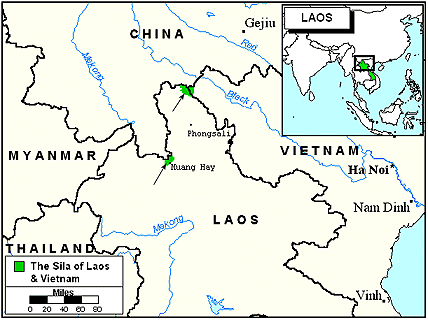|
|
Prayer Profile
The Sila of Laos
![[IMAGE]](../images2/0428.jpg) The Sila inhabit the hilly, tropical forests just north of Muong Hai in north central Laos. They are a Tibeto-Burman people with Mongoloid features and are an official nationality in Vietnam. Lacking specific information on the Sila, some assumptions have been made, based on their location in Laos as well as neighboring ethnic groups with similar backgrounds.
The Sila inhabit the hilly, tropical forests just north of Muong Hai in north central Laos. They are a Tibeto-Burman people with Mongoloid features and are an official nationality in Vietnam. Lacking specific information on the Sila, some assumptions have been made, based on their location in Laos as well as neighboring ethnic groups with similar backgrounds.
Like other Tibeto-Burman peoples, the Sila migrated from southern China into northern Laos. They are part of the Lolo linguistic groups, who were the dominant power in Southern China in the eighth and ninth centuries. In the early ninth century, they made their way into Southeast Asia.
Laos has been a pawn in the political competition between Vietnam, Russia, and China. As a result of the many foreign invasions and land wars, the people of Laos have experienced massive social upheaval and dislocation. Vietnam continues to give Laos some military support.
What are their lives like?
The hill peoples such as the Sila are hunters and gatherers of forest products, as well as farmers. However, their practice of shifting cultivation prevents them from establishing permanent villages. Hill peoples who live at higher elevations are firmly entrenched in their customs and traditions. In contrast, those who live closer to the lowland areas tend to engage in limited trade with the neighboring villages, acquiring their languages and cultures.
Sila villages consist of small groups of houses made of wood or bamboo, built on stilts, and clustered against the sides of the hills. Their residential areas are usually adjacent to their farm lands. With the houses built above the ground, the family livestockópoultry, pigs and goatsórun freely underneath the houses. Because their villages are usually organized around tribal lineage, it is likely that their social structure is based on family units.
The northern provinces of Laos have an ideal climate for growing opium-producing poppies. The tribal people are known to have traditionally used opium as a medicine, a cash or barter crop, and a drug. Drugs produced in this area generally move north on routes into China.
What are their beliefs?
The Sila practice an ethnic religion, which is often a blend of animism and ancestor worship. Animism includes the belief that forces and aspects of nature (wind, rivers, trees, earth) are attached to spirits or supernatural beings. These spirits help find or grow food, cure illness, and avert danger. Through sacrifice and ritual, the worshipper tries to manipulate the spirits into helping him.
Ancestor worship involves praying to the spirits of deceased ancestors for protection, guidance, or blessings. They believe that ancestral spirits are alive and must be fed and cared for.
What are their needs?
Laos is one of the poorest countries of southeastern Asia. Malaria, influenza, dysentery, and pneumonia are the major health problems, and malnutrition is widespread. Infant mortality rates are high, and life expectancy is low. Many of the elite fled the country in 1975, including most of the country's physicians, which created a serious problem for the new government. Village infirmaries and dispensaries were built, and medical workers were trained in most of the provinces. These village medical workers, often using only traditional medicinal herbs, now provide most of the country's primary health care, but it is not adequate for the great need.
The Vietnam War in the 1970's had a grave effect on the northern provinces of Laos. U.S. planes bombed northern Laos, where sizable North Vietnamese forces were fighting with the pro-Communist Pathet Lao. The Sila have possibly been affected by leftover land mines or cluster bomblets dropped by U.S. war planes. There is presently a Laos bomb removal project, but it has not yet reached their area. There are, however, mobile teaching teams bringing awareness and teaching mine clearance techniques.
Prayer Points
- Take authority over the spiritual principalities that have kept the Sila bound for many generations.
- Ask the Lord of the harvest to send Christian medical workers to labor among the Sila and the people of Laos.
- Ask God to speed the completion of the Jesus film and other Christian materials into the Sila language.
- Pray that God will reveal Himself to these precious people through dreams and visions.
- Ask God to strengthen, encourage, and protect the small number of Sila Christians.
- Pray that God will raise up qualified linguists to translate the Bible into the Sila language.
- Pray that God will open the hearts of Laotian governmental leaders to the Gospel.
- Ask the Lord to bring forth a triumphant Sila church for the glory of His name!

Statistics
Latest estimates from the World Evangelization Research Center.
THE PEOPLE
- People name: Sila
- Country: Laos
- Their language: Sila
- Population:
- Largest religion:
- Christian: 1%
- Church members: 223
- Scriptures in their own language: None
- Jesus Film in their own language: None
- Christian broadcasts in their own language: None
- Mission agencies working among this people: 0
- Persons who have heard the Gospel: 4,000 (18%)
- Persons who have never heard the Gospel: 18,300 (82%)
THEIR COUNTRY
- Country: Laos
- Population:
- Major peoples in size order:
- Major religions:
- Number of denominations: 8
© Copyright 1997
Bethany World Prayer Center
This profile may be copied and distributed without obtaining permission
as long as it is not altered, bound, published
or used for profit purposes.
![[HOME BUTTON]](../graphics/home.jpg)
![[CALENDAR BUTTON]](../graphics/calico.jpg)
![[LIST BUTTON]](../graphics/listico.jpg)
[Home]
[Calendar]
[Country List]
|